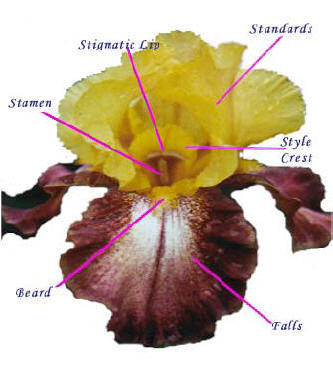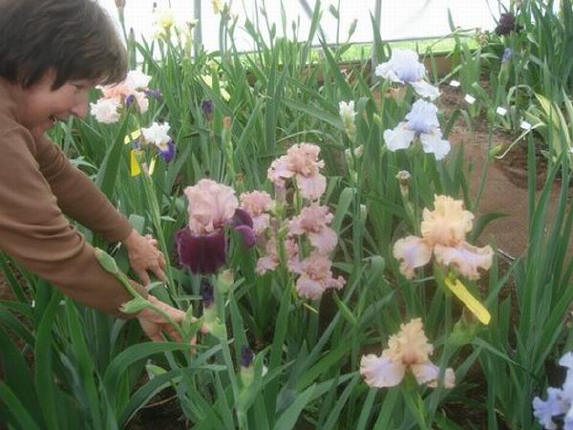Andy Crossland
Adams County
Master Gardener
 I am an unlikely candidate to be a
hybridizer of anything, much less the iris. The modern iris is wider, frillier and has more substance that its forbearer. The best modern irises have better branching and
many more flowers. Hybridizing iris is a formidable task, but a tour through a local hybridizing nursery can easily lure me into giving it a chance.
I am an unlikely candidate to be a
hybridizer of anything, much less the iris. The modern iris is wider, frillier and has more substance that its forbearer. The best modern irises have better branching and
many more flowers. Hybridizing iris is a formidable task, but a tour through a local hybridizing nursery can easily lure me into giving it a chance.
The nursery features six acres of iris to choose some favorites. My wife and I oohed and aahed and worked our way through the rainbow of blooms that
filled the hill top. I never knew that iris had a scent, but 6 acres of iris perfumed the area very nicely. We made our selections and were told how to prepare the beds. We
went home to pick locations and begin the process of tilling and improving the beds.
Let’s look at the anatomy of the iris bloom and discover what a labor of love it is to be able to introduce a new iris. The petals that go upward are
called Standards, the ones that arch down and out are called Falls. If you gently open the standards and look inside, you will see the Style Arms. At the ends of the style
arms is the fringe. This fringe is called the style crest. The best time to hybridize is about 3 or 4 hours after the flowers open. If you gently lift up the end of the style
crest, it separates and you will see the receptive stigmatic lips. Underneath this is the anther. The anther carries the pollen. Because of this anatomy, bees and butterflies
seldom pollinate Tall Bearded irises.

With a pair of tweezers, you remove an anther from the pollen parent and rub it on the lips of the pod parent. Fertilize all three
stigmata. You then put a tag on the stalk below the flower. The tag indicates the date; the pod parent is listed first, then an "X" (cross) and then the pollen parent. Now
you wait. You may see a slight swelling in a few weeks. Now the wait intensifies. You hope that nothing happens to stop the process. You hope nothing damages the pod, like a
storm or an animal breaking the stem. If you have an open garden, you may find helpful gardeners are the biggest danger to iris parenthood. Never deadhead in anyone’s garden
without asking! In the pod the miracle of life is taking place. Seeds form and are filled out. The plant knows what it needs to do to provide the best time frame for
successful propagation.
Enter the hybridizer. When the pod dries and the shell rattles with the seeds inside, you harvest the pod, making sure to keep the tags straight with
pods that they identify. You shell the seeds out and place them into a glass of water to soak for 3 days. Then you place them on top of dampened sphagnum moss in a small pot
and cover them slightly. The pot is marked with the tag and put into a small plastic bag. This is placed into the refrigerator for 3 months. On the allotted day remove the
bag from the pot. Water the pot and place it where you will be starting the new plants. If small leaves start to emerge, you can celebrate. Now you only have to worry about
damping off disease and a thousand other things that might get the babies.
When the plants are big enough, place them into separate small pots. Continue to grow the plants until the weather breaks. Now you line out the plants
into the seedling bed. Make sure that they are well marked. Tend the plants all year, keeping the weeds pulled and watering when needed. When winter comes, the babies
disappear under the snow. Spring finally pushes Old Man Winter back to his northern abode, and the rebirth of nature begins. Now if everything goes right your seedlings might
bloom, almost 2 years after they were just a gleam in a hybridizer’s eye. I guarantee that when they bloom you will encounter the most beautiful iris you have ever seen.
It isn’t difficult to fall under the spell of hybridizing irises. It is their allure that leads gardeners not only to grow some of the many varieties
that are available today, but to believe that they can hybridize some new varieties of their own. To see if you are strong enough to resist the allure of the iris, go to
www.irises.org, the website of the American Iris Society.
We come from the earth, we return to the earth. In between we garden. You meet the nicest people in the garden. See you in the garden.
Read other articles on plants and gardens